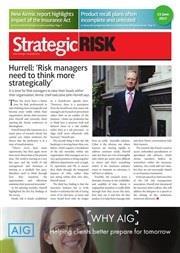Intangible risks increasingly top businesses’ key risk concerns

Insurance will need to evolve to remain relevant as companies are increasingly most concerned about intangible risks.
“Traditionally, insurance has covered tangible assets, because that used to be the value that companies held, whereas now, if you look at a world where Tesla has a market capitalisation greater than Ford, you realise it is actually future revenues which are the important determinant of value,” says Marc Davis, head of UK, Ireland & Mena at Swiss Re Corporate Solutions.
Speaking to StrategicRISK ahead of yesterday’s session on innovative risk solutions, Davis added: “Traditional insurance works less well in instances where we have insufficient claims experience, or the claims experience doesn’t show a stable pattern and the perils are very difficult to define and isolate. These risks include non-damage business interruption, contingent business interruption, supply chain, cyber and really any economic and business risk that exhibit some of those characteristics.”
He notes that innovative risk solutions look to protect (future) revenue streams or to enhance companies’ marketing and sales capability by using insurance in a different format.
An example of an innovative risk solution is a deal Swiss Re Corporate Solutions developed with a railway company, which looked at multi-peril non-damage business interruption cover.
“Most railways make their money over two or three lines, not over the whole network, and this particular company was very concerned that its revenue generation from its north-south and west-east lines could be impacted by regulatory shutdown. This could be caused by a number of circumstances, but the company was particularly concerned about the threat of a material damage which could close the line, in this case imminent rock fall,” Davis explains.
Swiss Re Corporate Solutions managed to put a solution together that covered cyber, regulatory shutdown, and the threat of material damage, which met a very specific need that wouldn’t have typically been covered under a traditional insurance policy.
Other innovative risk solutions the insurer has provided include loss of attraction for hoteliers in the Caribbean, which covered imminent loss of revenue because tourists simply no longer wanted to travel to a location, which would have an impact on the revenues for a hotel chain.
When creating innovative risk solutions, the active support and involvement of the risk manager is indispensable, Davis says. “Often the underlying issues and solutions are somewhat different from what risk managers typically deal with, but the fundamentals around these deals are exactly the same. It’s about risk identification, definition, quantification and ultimately management. Other stakeholders such as sales or treasury will need to be involved, as they normally hold the information that’s required to put a solution together, but ultimately risk management ensures that it’s suitable and consistent with the overarching risk management strategy of that company.”
Davis sees a consistent growth in demand for and supply of innovative risk solutions. “I think that’s partly driven by the current market environment, with little growth and opportunities in the traditional insurance space, but insurers are also being pressured by their clients and brokers to deliver alternative solutions.”
“As information is becoming more readily and more reliably available, it will become easier to set pricing and really determine the volatility that surrounds those intangible risks. Delving into these areas requires some bravery and a lot of effort, and customers need to make sure that what they are getting out of any product is going to meet their requirements and is going to respond in a way they expect it to.”




















No comments yet